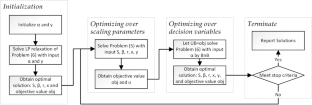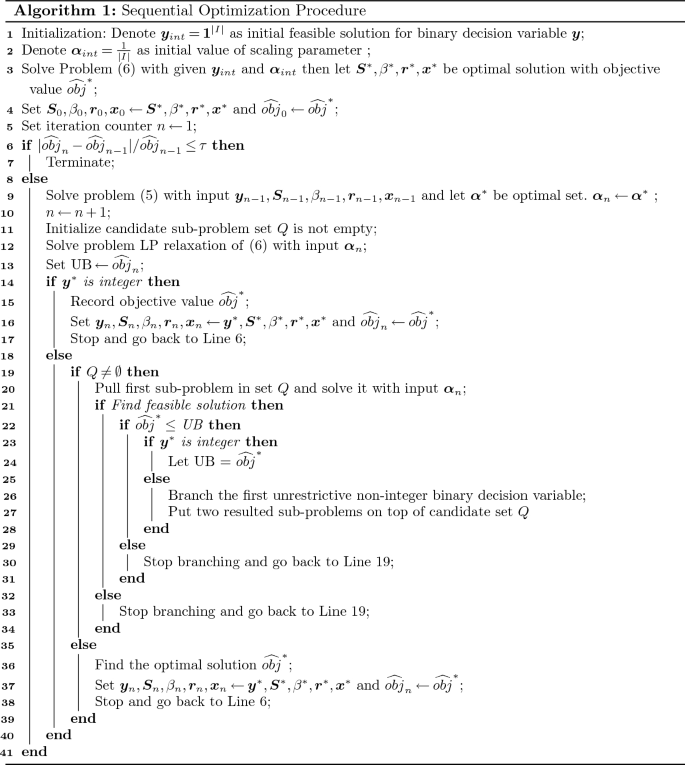Abstract
We propose a novel two-stage distributionally robust joint chance-constrained (DRJCC) model to design a resilient humanitarian relief network with uncertainties in demand and unit allocation cost of relief items in the post-disaster environment. This model determines the locations of the supply facilities with pre-positioning inventory levels and the transportation plans. We investigate the problem under two types of ambiguity sets: moment-based ambiguity and Wasserstein ambiguity. For moment-based ambiguity, we reformulate the problem into a mixed-integer conic program and solve it via a sequential optimization procedure by optimizing scaling parameters iteratively. For Wasserstein ambiguity, we reformulate the problem into a mixed-integer linear program. We conduct comprehensive numerical experiments to assess the computational efficiency of the proposed reformulation and algorithmic framework, and evaluate the reliability of the generated network by the proposed model. Through a case study in the Gulf Coast area, we demonstrate that the DRJCC model under Wasserstein ambiguity achieves a better trade-off between cost and network reliability in out-of-sample tests than the moment-based DRJCC model and the classical stochastic programming model.



Similar content being viewed by others
Data Availability
The data generated and analyzed during the current study are available in the GitHub repository, github.com/DRHRND2021/DRHRND2021.
References
Altay N, Green WG III (2006) OR/MS research in disaster operations management. Eur J Oper Res 175(1):475–493
Aslan E, Çelik M (2019) Pre-positioning of relief items under road/facility vulnerability with concurrent restoration and relief transportation. IISE Trans 51(8):847–868
Avila L, Stewart S, Berg R, Hagen A (2020) National hurricane center tropical cyclone report: Hurricane dorian. Technical report, National Hurricane Center, Miami, Florida, https://www.nhc.noaa.gov/data/tcr/AL052019_Dorian.pdf
Behl A, Dutta P (2019) Humanitarian supply chain management: a thematic literature review and future directions of research. Ann Oper Res 283(1):1001–1044
Bertsekas DP (2009) Convex optimization theory (Athena Scientific Belmont)
Chen W, Sim M, Sun J, Teo CP (2010) From CVaR to uncertainty set: implications in joint chance-constrained optimization. Oper Res 58(2):470–485
Chen Z, Kuhn D, Wiesemann W (2022) Data-driven chance constrained programs over Wasserstein balls. Oper Res. https://doi.org/10.1287/opre.2022.2330
CRED (2020) Natural disasters 2019: Now is the time to not give up. Technical report, Centre for Research on the Epidemiology of Disasters (CRED), Brussels, Belgium, https://reliefweb.int/report/world/natural-disasters-2019
Delage E, Ye Y (2010) Distributionally robust optimization under moment uncertainty with application to data-driven problems. Oper Res 58(3):595–612
Elçi Ö, Noyan N (2018) A chance-constrained two-stage stochastic programming model for humanitarian relief network design. Transp Res Part B Methodol 108:55–83
Elçi Ö, Noyan N, Bülbül K (2018) Chance-constrained stochastic programming under variable reliability levels with an application to humanitarian relief network design. Comput Oper Res 96:91–107
Esfahani PM, Kuhn D (2018) Data-driven distributionally robust optimization using the Wasserstein metric: performance guarantees and tractable reformulations. Math Program 171(1–2):115–166
Gao X (2019) A bi-level stochastic optimization model for multi-commodity rebalancing under uncertainty in disaster response. Ann Oper Res 319(1):115–148
Garrido RA, Lamas P, Pino FJ (2015) A stochastic programming approach for floods emergency logistics. Transp Res Part E Logistics Transp Rev 75:18–31
Ghosal S, Wiesemann W (2020) The distributionally robust chance-constrained vehicle routing problem. Oper Res 68(3):716–732
Grass E, Fischer K, Rams A (2020) An accelerated l-shaped method for solving two-stage stochastic programs in disaster management. Ann Oper Res 284(2):557–582
Ho-Nguyen N, Kılınç-Karzan F, Küçükyavuz S, Lee D (2021) Distributionally robust chance-constrained programs with right-hand side uncertainty under Wasserstein ambiguity. Math Program 196:641
Hong X, Lejeune MA, Noyan N (2015) Stochastic network design for disaster preparedness. IIE Trans 47(4):329–357
Hu C, Liu X, Hua Y (2016) A bi-objective robust model for emergency resource allocation under uncertainty. Int J Product Res 54(24):7421–7438
Hu S, Dong ZS (2019) Supplier selection and pre-positioning strategy in humanitarian relief. Omega 83:287–298
Hu S, Han C, Dong ZS, Meng L (2019) A multi-stage stochastic programming model for relief distribution considering the state of road network. Transp Res Part B Methodol 123:64–87
Isii K et al (1960) The extrema of probability determined by generalized moments (i) bounded random variables. Ann Inst Statistical Math 12(2):119–134
Ji R, Lejeune MA (2021) Data-driven distributionally robust chance-constrained optimization with Wasserstein metric. J Global Optim 79(4):779–811
Ji R, Lejeune MA (2021) Data-driven optimization of reward-risk ratio measures. Informs J Comput 33(3):1120–1137
Ji R, Lejeune MA, Fan Z (2021) Distributionally robust portfolio optimization with linearized STARR performance measure. Quant Financ 22(1):113–127
Kantorovich LV, Rubinshtein GG (1958) On a space of totally additive functions. Vestnik Leningradskogo Universitata 13:52–59
Liu K, Li Q, Zhang ZH (2019) Distributionally robust optimization of an emergency medical service station location and sizing problem with joint chance constraints. Transp Res Part B Methodol 119:79–101
Liu K, Zhang H, Zhang ZH (2021) The efficiency, equity and effectiveness of location strategies in humanitarian logistics: a robust chance-constrained approach. Transp Res Part E Logistics Transp Rev 156:102521
Mahootchi M, Golmohammadi S (2018) Developing a new stochastic model considering bi-directional relations in a natural disaster: a possible earthquake in Tehran (the capital of Islamic Republic of Iran). Ann Oper Res 269(1):439–473
Mohamadi A, Yaghoubi S (2017) A bi-objective stochastic model for emergency medical services network design with backup services for disasters under disruptions: an earthquake case study. Int J Disaster Risk Reduct 23:204–217
Mohammadi R, Ghomi SF, Jolai F (2016) Prepositioning emergency earthquake response supplies: A new multi-objective particle swarm optimization algorithm. Appl Math Modell 40(9–10):5183–5199
Nakao H, Shen S, Chen Z (2017) Network design in scarce data environment using moment-based distributionally robust optimization. Comput Oper Res 88:44–57
Ni W, Shu J, Song M (2018) Location and emergency inventory pre-positioning for disaster response operations: min-max robust model and a case study of yushu earthquake. Product Oper Manag 27(1):160–183
Noyan N, Meraklı M, Küçükyavuz S (2019) Two-stage stochastic programming under multivariate risk constraints with an application to humanitarian relief network design. Math Program 191:7–45
Rahimian H, Mehrotra S (2019) Distributionally robust optimization: a review. arXiv preprint arXiv:1908.05659
Rawls CG, Turnquist MA (2010) Pre-positioning of emergency supplies for disaster response. Transp Res Part B Methodo 44(4):521–534
Rennemo SJ, Rø KF, Hvattum LM, Tirado G (2014) A three-stage stochastic facility routing model for disaster response planning. Transp Res Part E Logistics Transp Rev 62:116–135
Sabbaghtorkan M, Batta R, He Q (2020) Prepositioning of assets and supplies in disaster operations management: review and research gap identification. Eur J Oper Res 284(1):1–19
Saif A, Delage E (2021) Data-driven distributionally robust capacitated facility location problem. Eur J Oper Res 291(3):995–1007
Sanci E, Daskin MS (2021) An integer l-shaped algorithm for the integrated location and network restoration problem in disaster relief. Transp Res Part B Methodol 145:152–184
Shehadeh KS, Tucker EL (2020) A distributionally robust optimization approach for location and inventory prepositioning of disaster relief supplies. arXiv preprint arXiv:2012.05387
Velasquez GA, Mayorga ME, Özaltın OY (2020) Prepositioning disaster relief supplies using robust optimization. IISE Trans 52(10):1122–1140
Wang C, Chen S (2020) A distributionally robust optimization for blood supply network considering disasters. Transp Res Part E Logistics Transp Rev 134:101840
Wang Q, Nie X (2019) A stochastic programming model for emergency supply planning considering traffic congestion. IISE Trans 51(8):910–920
Wang W, Yang K, Yang L, Gao Z (2021) Two-stage distributionally robust programming based on worst-case mean-CVaR criterion and application to disaster relief management. Transp Res Part E Logistics Transp Rev 149:102332
Xie W (2019) On distributionally robust chance constrained programs with Wasserstein distance. Math Program 186:115–155
Xie W, Ahmed S, Jiang R (2019) Optimized Bonferroni approximations of distributionally robust joint chance constraints. Math Program 191(1):79–112
Zhang J, Liu Y, Yu G, Shen ZJ (2021) Robustifying humanitarian relief systems against travel time uncertainty. Naval Res Logistics (NRL) 68(7):871–885
Zhang P, Liu Y, Yang G, Zhang G (2020) A distributionally robust optimization model for designing humanitarian relief network with resource reallocation. Soft Comput 24(4):2749–2767
Zhang P, Liu Y, Yang G, Zhang G (2020) A multi-objective distributionally robust model for sustainable last mile relief network design problem. Ann Oper Res 309:689–730
Zhang Y, Shen ZJM, Song S (2016) Distributionally robust optimization of two-stage lot-sizing problems. Product Oper Manag 25(12):2116–2131
Zhang Y, Shen ZJM, Song S (2017) Lagrangian relaxation for the reliable shortest path problem with correlated link travel times. Transp Res Part B Methodol 104:501–521
Zhong S, Cheng R, Jiang Y, Wang Z, Larsen A, Nielsen OA (2020) Risk-averse optimization of disaster relief facility location and vehicle routing under stochastic demand. Transp Res Part E Logistics Transp Rev 141:102015
Zokaee S, Bozorgi-Amiri A, Sadjadi SJ (2016) A robust optimization model for humanitarian relief chain design under uncertainty. Appl Math Modell 40(17–18):7996–8016
Zymler S, Kuhn D, Rustem B (2013) Distributionally robust joint chance constraints with second-order moment information. Math Program 137(1–2):167–198
Author information
Authors and Affiliations
Corresponding author
Ethics declarations
Conflict of interest
All authors certify that they have no affiliations with or involvement in any organization or entity with any financial interest or non-financial interest in the subject matter or materials discussed in this manuscript.
Additional information
Publisher's Note
Springer Nature remains neutral with regard to jurisdictional claims in published maps and institutional affiliations.
Appendices
Appendix A: Proof of Theorem 1
Proof
Following Theorem 3 of (Zhang et al. 2016), let \(\varvec{q}^*\) be the optimal solution for second-stage problem for given a feasible first-stage solution of decision variables \(\varvec{y}\) and \(\varvec{r}\). Denote \(\Psi (\varvec{y},\varvec{r})\) as a feasible set of \(\varvec{X}\) for given \(\varvec{y},\varvec{r}\). Let set \(\Lambda =\left\{ \varvec{x} \in {\mathbb {R}}^{|A|}: \;\; \begin{aligned} (\varvec{x}-\varvec{\mu }_{\zeta })^\intercal \varvec{\Sigma }_{\zeta }^{-1} (\varvec{x}-\varvec{\mu }_{\zeta }) \le \varphi ^2 \end{aligned} \right\} \subseteq {\mathbb {R}}^{|A|+}\). Then, we have
Note that \(\min _{\varvec{q} \in \Psi (\varvec{y},\varvec{r})} \varvec{q}^\intercal {\mathbb {E}}_{F} [\varvec{\zeta }] = {(\varvec{q}^*)}^\intercal {\mathbb {E}}_{F} [\varvec{\zeta }]\), by taking the maximum over \({\mathbb {E}}_{F} [\varvec{\zeta }] \in \Lambda\) on both sides of the equation, we have
We know that \(\varvec{q} \in \Psi (\varvec{y},\varvec{r})\), the next inequality follows:
Combining (10b) and (10c), we can get
According to minimax weak duality (Bertsekas 2009), we can easily get
Combining (10d) and (10e), we have
Because the optimal objective value of \(\max _{{\mathbb {E}} \left[ \varvec{\zeta }\right] \in \Lambda } \varvec{q}^\intercal {\mathbb {E}}_{F} [\varvec{\zeta }]\) is \(\varphi \sqrt{\varvec{q}^\intercal \varvec{\Sigma }_{\zeta }\varvec{q}} + \varvec{\mu }_{\zeta }^\intercal \varvec{q}\), we can get the reformulation in Theorem 1. \(\square\)
Appendix B: Proof of Theorem 2
Proof
Denote \(g_i = r_{i} + \sum _{(j,i)\in A} x_{ji} - \sum _{(i,j)\in A} x_{ij}\). According to the definition of the worst-case CVaR, constraint (4) can be expressed as follows:
To solve the worst-case CVaR problem, the following worst-case expectation (11b) should be solved at the beginning.
For fixed first-stage decision variables \(r_i, \; x_{ij} \in {\mathbb {R}}^+\) and \(\varvec{\alpha } \in {\mathcal {A}} = \{\varvec{\alpha } \in \varvec{R}^{|I|}:\varvec{\alpha }>\varvec{0} \}\), the worst-case expectation can be expressed as the following problem (12)
where F is probability measure on \({\mathbb {R}}^{|I|}\). Assign dual variables \(\delta _1 \in {\mathbb {R}},\varvec{\delta }_2 \in {\mathbb {R}}^{|I|}, \varvec{\Delta }_3 \in {\mathbb {Q}}^{|I|}\) to constraints (12b), (12c), and (12d), respectively. Then, we have the following dual problem (13)
Because \(\varvec{\Sigma }_{\zeta } \succ 0\), the strong duality holds between problems (12) and (13) (Isii et al. 1960). We assign an indicate vector \(\varvec{1}_i \in {\mathbb {R}}^{|I|}\) to represent a vector that have the ith element is 1, and the other elements are zero. The indicate vector \(\varvec{1}_i\) is used to represent the right-hand side of constraint (13c). Then, we have:
Denoting a combined decision variable \(\varvec{S} = \begin{bmatrix} &{}\varvec{\Delta }_3 \quad &{} \quad \varvec{\delta }_2 \\ &{}\varvec{\delta }_2 \quad &{} \quad \delta _1 \end{bmatrix}\), constraint (14) can be reformulated as:
where \(\varvec{0} \in {\mathbb {Q}}^{|I|}\) is a all zero matrix. By defining \(\varvec{\Omega } = \begin{bmatrix} \varvec{\Sigma }_{\zeta }+\varvec{\mu }_{\zeta } \varvec{\mu }_{\zeta }^\intercal \;&{}\; \varvec{\mu }_{\zeta } \\ \varvec{\mu }_{\zeta }^\intercal \;&{}\; 1 \end{bmatrix}\), we have the tractable reformulation for problem (11a). Therefore, Theorem 2 is proved. \(\square\)
Appendix C: Proof of Theorem 3
Proof
Because \(f(\varvec{y},\varvec{r},\varvec{\zeta },\varvec{\xi }) > - \infty\), according to Proposition 5.5.1 proposed by Bertsekas (2009), we have \(\sup _{F \in {\mathcal {F}}} \min _{\varvec{x}} {\mathbb {E}}_{F} [f(\varvec{y},\varvec{r},\varvec{\zeta },\varvec{\xi }) ] = \min _{\varvec{x}} \sup _{F \in {\mathcal {F}}} {\mathbb {E}}_{F} [f(\varvec{y},\varvec{r},\varvec{\zeta },\varvec{\xi }) ]\). For a feasible second-stage auxiliary decision vector \(\bar{\varvec{q}}\), the worst-case expectation \(\sup _{F \in {\mathcal {F}}} {\mathbb {E}}_{F} [ h(\bar{\varvec{q}},\varvec{\zeta }) ]\) can be acquired by solving following problem:
Developing Lagrangian function for problem (16), we get
Then, we have the dual problem of problem (16) as follows:
Constraint (17c) can be expressed as
Because the allocation cost cannot be negative, \(\Xi _F = [0, \infty ]\). Let \(\Delta \nu _m = \varvec{\zeta }-\hat{\varvec{\zeta }}_m\), then we have the Lagrangian function of (17e) as follows:
Then, we have the Lagrangian dual function of (17f)
where \(\Vert \cdot \Vert _p^*\) is the dual norm of \(l_p\) norm. Equality (17h) holds because of Lemma 1 in Zhang et al. (2017). If \(\Vert \bar{\varvec{q}} + \varvec{\gamma }_m \Vert _p^* - \lambda > 0\), the problem \(\sup _{\Delta \nu _m} L (\Delta \nu _m, \varvec{\gamma }_m )\) is unbounded. If \(\Vert \bar{\varvec{q}} + \varvec{\gamma }_m \Vert _p^* - \lambda \le 0\), the problem \(\sup _{\Delta \nu _m} L (\Delta \nu _m, \varvec{\gamma }_m )\) is equivalent with the following:
Bringing problem (18) back to (17c), we have a tractable reformulation of the problem DR-HRN. \(\square\)
Appendix D: Pseudo-code of Algorithm 1

Appendix E: Proof of Theorem 4
Proof
Based on Theorem 3 of Chen et al. (2022), the chance constraint (2b) can be reformulated as
where \(\textbf{dist}(\hat{\varvec{\xi }}_n, \varvec{g})\) is the distance between data point \(\hat{\varvec{\xi }}_n\) of the empirical distribution \({\widehat{G}}\) and the lower bound of feasible region. Therefore, we have
We denote the binary variable \(z_n\). Based on Proposition 2 of Chen et al. (2022), we have the reformulation for constraint (19c) as follows:
Then, according to Theorem 3 of Ho-Nguyen et al. (2021), the following reformulation is developed for constraint (19g) to improve the computational efficiency.
where \(N_{i}^*:= \{ n \in N: \xi _{in} > q_i \},\; \forall i \in I\) and \(q_i\) equal to the \(\lfloor \epsilon N \rfloor\)th largest value of \(\xi _{i}\). \(\square\)
Appendix F: Stochastic Programming Model
The uncertain parameter of scenario-based approach is given by a set of scenarios. The random variables \(\varvec{\zeta }\) and \(\varvec{\xi }\) are assumed to follow a discrete distribution independently. Let \(\zeta _{ijw}\) be the observation of the unit allocation cost between location i and j in scenario w and \(\xi _{iw}\) denote the demand at location i under the scenario w. We also assume that the probability of each scenario equal.
We reformulate the JCC to linear inequalities by defining a binary decision variable \(b_w\) and a large number M. The objective function of the SP model is formulated as first-stage cost plus the expected second-stage cost over all scenarios. Denote the scenario set W indexed by w. The model shows the following:
Constraints (20c) and (20d) ensure that the probability of the demand satisfaction for all scenarios is greater than \(1-\epsilon\). If \(b_w=1\), constraint (20d) equal to \(r_{i} + \sum _{(j,i)\in A} x_{jiw} - \sum _{(i,j)\in A} x_{ijw} \ge \xi _{iw}\), if \(b_w=0\), constraint (20d) is redundant.
Rights and permissions
Springer Nature or its licensor (e.g. a society or other partner) holds exclusive rights to this article under a publishing agreement with the author(s) or other rightsholder(s); author self-archiving of the accepted manuscript version of this article is solely governed by the terms of such publishing agreement and applicable law.
About this article
Cite this article
Jiang, Z., Ji, R. & Dong, Z.S. A distributionally robust chance-constrained model for humanitarian relief network design. OR Spectrum 45, 1153–1195 (2023). https://doi.org/10.1007/s00291-023-00726-y
Received:
Accepted:
Published:
Issue Date:
DOI: https://doi.org/10.1007/s00291-023-00726-y




